Variation: Citrus Angel Food Cake

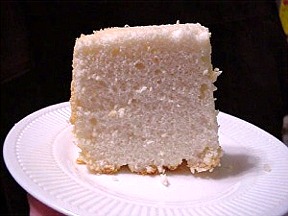
I remember my Grandmother making this recipe, which I have recorded and written in much more detail here. She used to make the recipe by memory and hand, with a huge wire whip. I remember how odd it was when she turned it upside-down on her funnel to cool when it was hot, right from the oven. The grown-ups enjoyed the cake with fresh fruits or ice cream, but I always preferred to eat it unadorned, and the more of the crunchy brown top I had, the happier I was. Oh, and for a special treat, we used to thinly slice the cake and toast it until light golden, something I still enjoy doing today!! Angel food cake batters can be easily flavored with different extracts, such as vanilla, almond, lemon or orange. After the last of the flour has been folded in, you can fold in other ingredients such as crushed peppermint candies, finely chopped well-drained maraschino cherries, grated semisweet chocolate or chocolate chips – mini's are the best, if you can find.
Angel Food Cakes are a member of the foam cake family, as Chiffon and Sponge Cakes. Nostalgia apart, all members of this cake family rely heavily on properly executed techniques to ensure their lofty and airy success. If followed to a tee, you will be amply rewarded and joyfully pleased! Angel Food cakes structures come mainly from egg white foams – a large proportion of beaten egg whites with sugar – and from a smaller proportion of flour folded in afterwards. Sugar is used as a whipping aid helping to produce the foams; its crystal size serves to determine the air hole size in the foam. Sugar dissolves with the liquid from the beaten eggs, making it thick and cohesive, greatly slows its demise or drainage from the bubble walls and the eventual coarsening of its texture. Suoer-fine sugar contributes to a light, delicate recipe because its small grains dissolve into the Angel Food Cake batter very quickly, while a coarser crystal (regular sugar) might not be incorporated as fully or as quickly. I prefer to use powdered sugar because it dissolves almost instantly. I find it gives a melt-in-your-mouth texture. It is sugar that has been completely pulverized into a very fine powder, often with a small amount of cornstarch added to it to keep it from clumping together. (Cornstarch also helps make the cake not as tough because it helps reduce the gluten protein percent in the recipe!)
CAKE RECIPE HELP
kake, Premium Member, Says: “I made (this) Angel food cake. IT WAS DELICIOUS! light and fluffy. my whole family just love it. It is easy to make and easy to clean. no sticky oil.”
INGREDIENTS
1 cup bleached cake flour, not self-rising, sifted; spoon into dry measuring cup and level to top and then, sift. Do NOT use a cake flour substitute.
1 1/2 cups powdered (confectioners') sugar or superfine or regular sugar, divided, sifted; sift after measuring
1/4 teaspoon salt
12 (about 1 1/2 cups) large egg whites
1 1/2 teaspoons cream of tartar or 1 teaspoon lemon juice; find cream of tartar in the grocery store or via mail order
2 teaspoons vanilla extract; use extracts, only – do not use flavored candy oils because they will deflate the egg whites
INSTRUCTIONS
STEP I: PREHEAT THE OVEN, PREPARE THE ANGEL FOOD CAKE PAN, AND SIFT THE FLOUR, SUGAR AND SALT
1. Position the oven rack in the center of the oven and preheat the oven. Remove the top racks so the cake has enough room to rise at least an inch above the pan (pan is 4-inches tall).
SARAH SAYS: In my oven, the center rack is the third rung up. When you have an even number of racks, as I do in my oven, when in doubt, select the lower rack of the two.
Preheat the oven to 350 degrees F. NOTE: Do NOT reduce the oven heat by 25 degrees F if using a dark pan. (Bake the cake for 35 – 40 minutes.)
2. Use a light colored aluminum pan called an “Angel Food” Cake or Tube Pan that is 10- x 4-inches with a removable bottom. DO NOT use a non stick pan.
DO NOT grease the pan.
Many stores still call the pan a “tube” pan because of the tube in the center, but be sure to purchase a pan with a removable bottom. You need it to ensure the cake will come out easily.
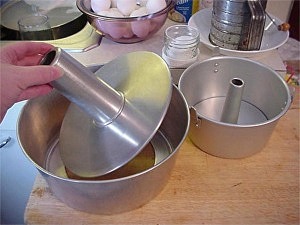
SARAH SAYS: The size and shape of a baking pan is crucial; it should allow for the proper expansion of the egg whites during baking. Angel food cakes are best baked in an ungreased tube pan with straight sides. That's so the whites can rise during baking. Because an angel food cake does not have a strong gluten structure or chemical leavening, it needs the pan sides to virtually cling to while baking. If greased or nonstick, the egg whites would slip downwards, causing a flat and deflated cake.
3. After measuring the ingredients, sift the flour, 3/4 cup powdered sugar and salt. Sift the mixture two more times and set aside. This ensures the mixture is completely free of lumps and is aerated.
NOTE: If using superfine or regular sugar in the recipe instead of powdered sugar, just sift the flour and salt together a few times. Then, add in the sugar.



STEP II: BEAT THE EGG WHITES
Beat the egg whites until they are stiff and glossy. Use a stand mixer when you have a large amount of whites to beat, such as this recipe where you are beating a dozen egg whites.
NOTES: It is very important that anything that comes in contact with the egg whites is clean and completely free from any grease, oil or fat of any kind. Even a tiny drop of the yolk mixed in with the whites will keep the whites from accepting air. This is also true with your whisk or beaters.
Before starting, wipe the clean implements with lemon juice or white wine vinegar, rinse both in warm water, and then dry. Don't use plastic containers because they tend to absorb and retain fat even if washed.
1. Place egg whites in a clean, dry spotless mixer bowl of a stand mixer. Make sure there are no egg shells in the mixture.
2. With a stand mixer fitted with a whisk attachment, begin beating the egg whites on medium-low speed.
SARAH SAYS: As air is beaten into the egg whites, they will start to lighten in color. This beginning step is one of the most overlooked and important steps.
If egg whites are beaten too quickly at the beginning, the structure of the foam will not be as strong, and later the egg whites will not beat as high as they should.
3. When the egg white foam increases in volume and becomes white with large bubbles, immediately add the cream of tartar at the side of the bowl.
Increase the mixer speed to medium.


SARAH SAYS: Adding a small amount of acid, such as cream of tartar or lemon juice, stabilizes egg whites and allows them to reach their full volume and stiffness.
It does this by making the egg coagulate faster. Do not add the salt here.
5. When the bubbles in the egg white foam will become smaller and more even in size, increase the mixer speed to medium-high.
Immediately, add the remaining powdered sugar (3/4 cup) slowly in a steady stream at the side of the bowl. Then, increase the mixer speed to high.

SARAH SAYS: Always add sugar in a stream, slowly at the side of the bowl while the whites are being whipped; do not dump it in the center — you don't want to risk deflating the whites.
I stopped the mixer so you could see how the egg white foam is beginning to become glossy. This is called the soft peak stage.
It is reached when the peaks of the whites droop slightly, when the beater is turned off and lifted. But, this recipe calls for beating the whites to the stiff peak stage…so keep beating with the mixer on high.

6. Beat until the egg whites are white, fluffy, very stiff and still very glossy. Add the vanilla in the final moments of whipping.
For this recipe, the whites should be stiffer than most. They will form lumps as the mixer beats. STOP beating when they start to form lumps around the beater as shown in the photo.


SARAH SAYS: If egg whites are beaten to dry and dull, they are overbeaten — Watch carefully, because egg whites can go from stiff to dry and overbeaten in as little as 30 seconds.
To test if properly beaten to the stiffly beaten stage, take the mixer bowl from the mixer or lift the beaters.
You can gently cut a table or icing knife through the middle of the beaten egg whites; it creates a narrow grove with stiff walls.
If not, continue beating for a few seconds more and perform the test, again.

SARAH SAYS: Another test to perform to see if your egg whites are stiffly beaten are to stop the beaters and then lift them — straight and stiff peaks should form.
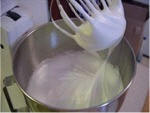
SARAH SAYS: Use your whites in the recipe immediately upon beating them. If they sit for more than 5 minutes, they start to deflate, so whip again by hand with a whisk, if they do.
They will keep a bit longer if the foam contains sugar or an acid, such as cream of tartar or lemon juice, which ours does.
QUESTION: HELP! I've overbeaten my egg white mixture. Do I have to throw them out and start again! I just wasted twelve eggs and all of the time separating them…I'm heart broken!
SARAH SAYS: Do not overbeat the egg whites; if they are beaten too stiff, they lose their gloss and look curdled. Unfortunately, there is no more stretch left for them to rise when baked — some or will pop during the whipping stage and will collapse. To fix, try whisking in another egg white with a wire whisk — DO NOT use the electric mixer. If you can't fix them, unfortunately, you have to start over again with fresh egg whites…
STEP III: FOLD THE FLOUR MIXTURE INTO THE BEATEN EGG WHITES
Fold the egg whites and the batter mixture until thoroughly blended
SARAH SAYS: When you fold the flour and beaten egg whites together, they must be thoroughly blended together; you need to make sure all of the air bubbles are encased in flour, otherwise the cake won't rise properly. The flour's proteins and starches will set around the air bubbles when the cake bakes in the oven, allowing it to puff properly. In essence, the folding action breaks up the air bubbles into smaller ones and encases each one in batter, like putting mortar in between small tiles to hold them in place. If the “mortar” isn't evenly distributed between the “tiles” and you have some large and small tiles, you'll get an uneven looking “floor” or cake crumb. Some “tiles” or air bubbles will be “loose” or escape from the cake batter and cause large holes in the cake. You'll see a pattern of “tiles” or egg whites grouped together separately from a layer or “mortar” or batter grouped together. Your “floor” or cake will be uneven and won't rise as high in the oven. With foam cakes, it's normal to see some uneven air holes in the cake's crumb (inside), but not large pockets of air holes, egg whites and/or batter. That means that the folding action was not done enough or was done too much where you managed to pop a lot of air bubbles. Folding takes a lot of practice to get right.
1. Sift one third of the flour/powdered sugar mixture over the top of the beaten egg whites. Fold together with gentle strokes.
To do, with a large rubber spatula cut through the center of the beaten egg whites, scraping the bottom of the bowl as you go, and bring the bottom of the egg whites up and over the top of the flour. Make sure you rotate the bowl a quarter turn after each stroke.


2. When you cannot see flour on the surface, sift the next third over the top and repeat until all of the flour has been folded into the beaten egg whites.
The finished batter should be firm, but fluffy and soft. It will lose its high shine and have a more matte finish because of the flour.


HELP! When I baked my Angel Food Cake, it had a dense, moist layer at the bottom. Why did it happen and what can I do to save my cake? I hate to throw it away!
RESCUE: Next time, fold the ingredients until thoroughly mixed taking care not to deflate the mixture. After folding, if you still see streaks of batter and egg whites, the Angel Food Cake won't rise as high and you may find a dense, moist layer at the bottom of the baked cake. If you do, simply cut off the “bad” layer with a sharp, serrated knife and split the cake into multiple horizontal layers.
3. Gently scoop the angel food cake batter into the ungreased pan.


4. Run a thin knife through the cake batter once or twice. This prevents air pockets from forming in the body of the cake.

5. Run a clean, damp cloth around the edges to clean the side of the pan.

STEP IV: BAKE THE ANGEL FOOD CAKE AND INVERT. UNMOLD AND SERVE
Bake and Invert:
1. Bake the cake in a well-preheated oven for 35 – 40 minutes:
Place the cake immediately in a well preheated oven, and shut the oven door immediately. Do not open it until the cake is almost done baking.
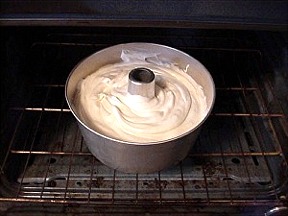
The cake will rise and sometimes even rise above the edge of the pan. It is done when you see no moisture beads in the cracks on the surface and the top is golden brown.
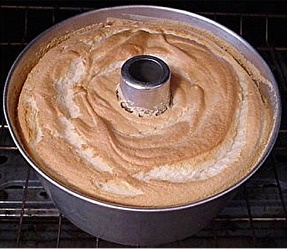
SARAH SAYS: As long as an Angel Food Cake cake “sings” in the oven, it is really the eggs releasing steam and is not done. When the “singing” stops and the cake is nicely browned and springy to the touch, take it from the oven. Also, Angel food cakes will not shrink from the sides of the pan as other cakes do when baked, and the cracks in its crust should be a tad moist, but not damp batter.
2. When done baking, remove the cake from the oven and immediately turn the pan over the neck of a neck of a soda or wine bottle, or funnel, which I prefer to use – it is more stable than a bottle. This is just a demo of what it should look like, that's why you can't see any cake – there isn't any in the pan at the moment!

SARAH SAYS: Do not use the little tabs on top of the pan to rest the cake on to cool; it will not raise the cake high enough from the countertop to cool and will cause condensation to form on top of the cake. This will cause a sticky cake top!
Proper cooling is just as important as baking. The cake is inverted in its pan to cool which prevents its structure from shrinking or falling, giving it the open texture that's characteristic of these cakes. If placed to cool on a rack, it would deflate much of that hard-earned volume.
Unmold:
1. When the cake has thoroughly cooled, have the plate you will serve the cake on ready to go.
When cool, gently loosen the sides of cake with a thin-bladed, flexible knife, moving the knife firmly in one direction; do not use a sawing motion otherwise you will gouge or scrape some of the crust off the side of the cake.
A. Slowly trace around the perimeter of the inner tube with a thin-bladed knife, scraping against the pan rather than the cake.

B. Then, slowly trace around the perimeter of the pan with a knife, scraping against the pan rather than the cake.

C. When loose, push up the bottom to remove the cake from the outer ring. The central tube will be attached. Cover the cake with a serving plate, and at the same time holding both, invert the cake onto the plate. With a thin-bladed, flexible knife, carefully trace around the bottom of the pan and the cake. It will simply fall onto the plate. Lift the bottom and inner tube from the cake.


Serve:
1. The finished cake should be tender, not mushy.
When you cut it, use a serrated knife and make small, quick sawing motions.

The Angel Food Cake is perfect by itself, dusted with sifted powdered sugar or embellished for a spectacular dessert.
But, it is also the perfect base for fresh fruit, the cake will absorb any liquid and you will be able to enjoy it down to the last bite!
STORAGE
Angel Food Cakes don't store well because they become sticky from the high amounts of sugar and egg whites. However, store your cake at room temperature for a couple of days at most, covered in plastic wrap. In humid weather the cake will become especially sticky. You can freeze Angel Food Cakes, but their texture and flavor will suffer. Upon thawing, the cake will be more dense and not as flavorful.

VARIATIONS
CITRUS ANGEL FOOD CAKE
Reduce the vanilla extract to 1 teaspoon
Add in:
1 tablespoon fresh orange juice or water
grated peels of 1 orange and 1 lemon; do not use flavored candy oils because they will deflate the egg whites
Add to Step #6. Beat until the egg whites are white, fluffy, very stiff and still very glossy. Add the vanilla >>>orange juice and grated peels>>> in the final moments of whipping.
SERVING SUGGESTIONS
Top with chocolate and caramel sauces, sprinkled with toasted chopped almonds or coconut.
Drizzle with a glaze, such as a Chocolate Ganache Glaze (or an Easy Chocolate Ganache), a Basic Powdered Sugar Glaze or Easy Flavored Glazes.
Simply hollow out the center section of a tube-shaped angel food cake and fill with and flavored stabilized whipping cream or whipped topping.
Serve with an easy Raspberry sauce topped with sweetened or flavored whipped cream for a stunning dessert
Fill by cutting the cooled cake in half horizontally with a serrated knife. Then, hollow out the bottom section and fill with a flavored Stabilized Whipped Cream, Custard, Lemon or Dark Chocolate Ganache Mousse. Replace the top layer on it, press lightly and serve.
Because it contains no fat, an Angel food cake is perfect as a healthy dessert.
Serve as is with a Fresh Pear compote
Fill by cutting the cooled cake in half horizontally with a serrated knife. Then, hollow out the bottom section and fill with my Reduced-Fat Custard. Sprinkle some (canned and drained) Mandarin oranges slices on top. Then, place the top section back on, pressing lightly into place. Finish with an Apricot or an easy Orange Glaze.
Make an Angel Food Shortcake: Fill layer (as above) with my Reduced-fat Whipped Cream. Sprinkle some fresh sliced strawberries on it and replace the top, pressing lightly. Serve with a Fresh Strawberry Compote –Yum! YUM!
An Angel food cake is perfect for making a low-fat Trifle with.


